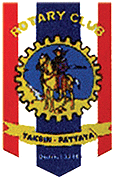- HEADLINES [click on headline to view story]:
-
1st Japanese language, cultural school to open in Sriracha
-
Andrew Wood’s friends mutter a Mantra
-
Building a school on top of a mountain
-
Elephants with a sweet tooth delight Nong Nooch guests
|
|
1st Japanese language, cultural school to open in Sriracha
Sawittree Namwiwatsuk
Responding to the large number of Japanese factory workers in the
area, Waseda Education (Thailand) Co. Ltd. will open a Japanese language and
cultural school in Sriracha in October.
 Boonyasith
Chokwatana, president of the Sahapat Group, presides over the Waseda
International Cultural Center construction ceremony. Boonyasith
Chokwatana, president of the Sahapat Group, presides over the Waseda
International Cultural Center construction ceremony.
The school, to be constructed on two rai of land donated by subsidiary
Sahapattana Inter Holdings (Public) Co., Ltd. is the first of its kind on
the Eastern Seaboard and is aimed at employees of Japanese car, electronics
and other plants who want to increase their Japanese language skills and
learn more about the culture.
Boonyasith Chokwatana, president of the Sahapat Group, said Sahapattana,
which manages Waseda’s other properties in Bangkok, will also build a
shopping center on an adjacent rai of land that will feature Sahapat
products and other locally produced goods.
Waseda Director Sirikul Tanasansilp said the new three-storey facility will
cost 40 million baht. Its 2,300 sq. m of floor space will include a
basement-level exhibition area, a second-floor classroom level and
accommodations on the third floor.
Courses will include Japanese language for business, a weekends-only
language course and cultural exchange programs, including a culture camp.
“The school’s syllabus will emphasize teaching the Japanese language to
people working with Japanese people,” Sirikul said. “It will be divided into
three levels; basic Japanese, advanced comprehension and the progressive
level, equal to a Japanese native. We have both an accelerated course and a
normal course. All of the students will receive certificates and the school
is licensed by the Ministry of Education,” Sirikul said.
Andrew Wood’s friends mutter a Mantra
Dr. Iain Corness
What does an hotelier do to celebrate his birthday? He goes to someone else’s
property and celebrates there. At least he doesn’t have to wash up!
 Together
forever, Andrew and Corry Bik. Together
forever, Andrew and Corry Bik.
The celebrant was Andrew Wood, the GM of the Chaophya Park group of hotels,
National Councillor of Skๅl International and in a previous lifetime GM of one
of Pattaya’s five star properties. The venue he selected to celebrate with some
of his close friends was the Mantra and the event was the Sunday Brunch on
January 3.
The beginning was in the Mantra cocktail area where his guests caught up with
their latest toings and froings over a ‘bloody mary’ or two. Or was that three,
before descending upon the restaurant area.
The Mantra Sunday Brunch has a very faithful following these days and with
freshly shucked oysters, Alaskan king crab legs (I swear those things must stand
a meter and a half tall), steamed giant scallops and sushi choices, it is no
wonder (and that was just for starters)! The seven Mantra live cooking stations
offer much more, including a raclette cheese with new potatoes and gherkins. You
would not be able to try them all in a week of Sunday Brunches.
Amari Orchid and Tower GM David Cumming also dropped by, as one GM does for
another, and left some champagne to give the birthday brunch just that little
bit more ‘fizz’.
Hoping there was just a little space left, a birthday cake also appeared like
magic, with Andrew Wood heard muttering under his breath “I hope it’s for
somebody else.” But it wasn’t!
Happy Birthday, Andrew!

Friends gather to wish Andrew Wood
(3rd left) a Happy Birthday.
Building a school on top of a mountain
Master of Ceremonies “Hawaii” Bob Sutterfield welcomed
everyone to the regular Sunday meeting of the Pattaya City Expats Club on
December 27 at the Amari’s Henry J. Beans Restaurant. After the usual
announcements, he introduced Nathan Russo whose topic was about how the
dedication of a few individuals resulted in the building of school for the
children of the Hmong village of Khun Ta in Thailand.
Nathan said he retired about 2 years ago from a property and appraisal company
he founded in New York. He divides his time spending about one half of the year
on St. Simon Island in Georgia (USA) and the other half in Thailand.
 Nathan
Russo (right) introduces Thitiporn (Apple) Pantachang, a professor at
Rajamangala University of Technology in Chiang Rai. Apple inspired Nathan to
find a way to build a school that she designed, and the school has now been
completed. Nathan
Russo (right) introduces Thitiporn (Apple) Pantachang, a professor at
Rajamangala University of Technology in Chiang Rai. Apple inspired Nathan to
find a way to build a school that she designed, and the school has now been
completed.
Before he started his presentation, he introduced Thitiporn (Apple) Pantachang,
a professor at Rajamangala University of Technology in Chiang Rai. Her teaching
engineering students has led her and her students into school building projects
without the help of government or non-government organizations. Nathan said it
was through her that he first became aware of the village and its need for a new
grammar school building.
It started with Apple inviting him to go with her to visit the village, which is
located on a mountaintop in the Teung district of Chiang Rai province near the
Lao border. He said they were greeted by the villagers and about 100 children
upon arrival. She showed him a two room school house her engineering students
had built the previous year and then another dilapidated building that served as
the grammar school.
After the tour, she wanted to know if Nathan could raise the money to replace
the old structure. Nathan thought to himself that it could probably be done for
about US $3,000 to $4,000. So he told her to send him a cost analysis and some
engineering drawings. Nathan said that he was trying to be polite and thought
she would never send him anything and that he would not need concern himself
with building a school at the top of a mountain.
Without hearing anything from Apple for over 7 months, Nathan said he was sure
that was the end of the matter. But, to his surprise, soon thereafter, he did
receive an email with the information he had requested attached. Nathan
confessed that he had no experience in construction and really didn’t understand
the spreadsheet and drawings he received. But, he did understand the overall
cost estimate that was shown, which was US $13,000.
He contacted Apple to tell her he had no idea how to raise that much money and
if he did, it would probably take a couple of years to do it. Nathan said he
felt bad about it, but believed that she would probably find someone else to
take on the project.
However, shortly thereafter, he again thought of the school while watching a
show about eco tourism in Thailand on the Discovery Channel. He said he noted
one of the contributors to the program, Armin Soch with Impulse Tours in Chiang
Mai. He got in touch with Armin to tell him about Apple and her project. Without
making any promises, Armin agreed to meet with Nathan on his next trip to
Thailand.
In January of 2009, they met in Bangkok and this led to meeting Marc Dumur,
general manager of the Legend Hotel in Chiang Rai who was someone with knowledge
about building things in Thailand. Armin and Marc met with Apple and visited the
village. As a result, they became very excited about the project and started
things moving.
Nathan said the three of them opened a bank account and made some initial
contribution toward the project. Then they set out to get more contributions to
meet the goal of raising US $13,000.
Nathan then described how they went about obtaining more funds with each of them
making an effort in their respective locations in Thailand as well as
Switzerland and America. Since the university students needed to start
construction in October during their school break, they had only 7 months to
accomplish their task.
Although much of the funding came from many small donors, Nathan said they did
have a few gracious donors that made some substantial contributions. One was
from a Swiss lady who had set up a foundation in Thailand in honor of two of her
children that were lost in the tsunami. There were also a couple of generous
Americans living in Pattaya that made large donations.
Once they had some funding, they then had to start purchasing the building
materials and truck them up the mountain over a very bad road that became mired
in mud during the rainy season.
In concluding, Nathan said everything came together to start construction. In
addition to the university students, some Swiss donors also arranged and paid
for some of their children to come to Thailand and assist in the construction.
These high school kids had a great time “roughing it” on the mountaintop while
working under the direction of the Thai engineering students. Nathan said that
these students were the key to success as they persevered during some very bad
rainy weather to complete the construction.
Once the last coat of paint was applied Marc checked the bank account and found
$2,000 was left. This was used to buy new school books and materials for school
furniture, which was built by the students.
On November 7, 2009, they held a dedication ceremony at the new school building
involving several of the village children dancing in their traditional Hmong
costumes and several speeches from those involved and local dignitaries. Nathan
then answered several questions from the audience.
The meeting was concluded with Harry “Sig” Sigworth conducting the always
informative Open Forum where everyone has an opportunity to ask and answer
questions about living in Thailand and Pattaya in particular.
Elephants with a sweet tooth
delight Nong Nooch guests
Patcharapol Panrak
Two Nong Nooch Tropical Garden elephants with a sweet tooth delighted
tourists New Year’s Eve by taking tips they received from their show to buy ice
cream without their handler’s help.
 The
two talented elephants took money earned by dancing and bought themselves some
ice cream at a local kiosk. The
two talented elephants took money earned by dancing and bought themselves some
ice cream at a local kiosk.
After a performance by two three-year old elephants, Nong Nooch brought out
7-year-old Trutcheen and 5-year-old Christmas to entertain guests who missed the
first show. The tourists were so impressed with the pachyderms’ Thai dancing
skills, they rewarded the elephants and mahout Noi Mali-ngamto with cash
rewards.
But the audience was astonished when the intelligent elephants took the money
and walked themselves over to an ice cream stand to buy a cone.
Nong Nooch Director Kampol Tansatcha said it was the first time he’d ever seen
elephants do that and didn’t even know the big animals even liked ice cream.
Perhaps, he said, the elephants had seen tourists buying their own cones and
were jealous. After all, he said, one elephant had gotten a taste of the frosty
delight once when it took a cone out of the hand of a surprised Chinese visitor.
To prove they weren’t one-trick ponies, the elephants repeated their ice
cream-buying ways when the delighted tourists gave them more tips. Finally,
however, Noi had to put a stop to it for fear his elephants would get a tummy
ache.
|
|

News | Business | Features |
Columns | Mail Bag |
Sports | Auto Mania
Our Children | Travel |
Our Community | Dining Out & Entertainment
Social Scene | Classifieds |
Community Happenings | Books Music Movies
Clubs in Pattaya | Sports Round-Up
E-mail: [email protected]
Pattaya Mail Publishing Co.Ltd.
62/284-286 Thepprasit Road, (Between Soi 6 & 8) Moo 12, Pattaya City
T. Nongprue, A. Banglamung,
Chonburi 20150 Thailand
Tel.66-38 411 240-1, 413 240-1, Fax:66-38 427 596
Copyright © 2004 Pattaya Mail. All rights reserved.
This material may not be published, broadcast, rewritten, or redistributed.

|
|

Rotary
International

www.rotary-jomtien.org

www.rotary-taksin.org

|